Dr. Tran Chi Trung
Vietnam Academy for Water Resources
I. Overview of the management of small and On-farm irrigation works in Vietnam
1.1 Small irrigation works, on-farm irrigation
Up to now, Vietnam has built thousands of irrigation works systems, including 6,648 reservoirs of all kinds, about 10,000 large electric pumping stations, 5,500 large irrigation sluices, 234,000 km of canals, 25,960 km of dikes of all kinds. These irrigation works provide irrigation for over 7.3 million hectares of rice land (Winter-spring crop: 2.99 million hectares, Summer-Autumn crop: 2.05 million hectares, Winter crop: 2.02 million hectares) contributing to agriculture production, so that food production increased rapidly and stably
Small irrigation works include 3,957 reservoirs with a capacity of 50,000÷500,000 m3, 15,900 permanent weirs with height less than 10m, 16,000 temporary dams, nearly 10,000 pumping stations with total discharge of 1,000÷. 3,600 m3/h, 174,000 km of tertiary canals and on-farm canals; In addition, there are thousands of ponds and lakes with capacity of less than 50,000 m3, pumping stations with discharge less than 1000 m3/h and other canals.
Small irrigation infrastructure and on-farm irrigation system plays an important role, deciding the efficiency of surface water use, determining productivity and quality of agricultural products, contributing to improving people’s lives. Small irrigation schemes play an important role in serving agricultural production, irrigating about 47% of irrigated area in Vietnam.
1.2 Policy on management of small irrigation works, on-farm irrigation system
- Law on Irrigation:
- The water user organizations manage small irrigation works and on-farm irrigation system
- When water user organizations have enough capacity, they will establish a union of water user organizations to manage inter-commune canals
- Funds for small-scale schemes and on-farm irrigation activities include: Contributed by organizations and individuals using irrigation services and supported by the State.
- Circular 05-Ministry of Agriculture and Rural Development:
- Small irrigation works, on-farm irrigation are directly managed water user organizations or selected organizations and individuals to manage and exploit.
- For small irrigation works, the water user organization set up operation process and irrigation planning
- The point of delivery of irrigation services between the irrigation management company and the water user organization is is determined by scale of on-farm irrigation scale (50 ha – 400 ha)
- Eater user organizations develop and implement plans for water supply, irrigation, drainage and drainage, maintenance of irrigation works with participation of water users.
- Water user organizations participates in formulating plan for water supply, irrigation, drainage and drainage of the irrigation management company.

Figure 1. Diagram for point of delivery of irrigation services
- National set of criteria for new rural communes for period of 2021 – 2025:
Irrigation criteria for new rural communes: The percentage of agricultural production land that is actively irrigated and drained: Over 80% for standard rural communes, over 80% for enhanced rural communes. 90%
1.3 Organization managing small irrigation works and on-farm irrigation system
The whole country has a total of 97 provincial-level organizations, of which there are 82 irrigation management companies (accounting for 84%), 3 management boards for exploitation of irrigation works (5%), 6 irrigation management centers (6%) and 6 irrigation sub-departments (5%) in charge of managing irrigation works in the province.
Regarding management of small irrigation works and on-farm system, there are 16,238 water-using organizations nationwide, including following main types: Cooperatives providing irrigation services (agricultural services Cooperatives, Cooperatives specializing in irrigation), Water User Association, Cooperative Group, Irrigation Team and Irrigation Management Board. In which, cooperatives and cooperative groups are two main types, accounting for 90% of water users organizations.
The management of irrigation works are gradually coming into order, serving well production and people’s daily life. Activities of organizations managing irrigation works basically meet requirements of production and people’s daily life. However, establishment and operation of water user organizations are still heavily imposed, lacking active participation of people. This is the most important and fundamental reason why many water user organizations are unsustainable.
 II.Status of making and implementing irrigation plan
II.Status of making and implementing irrigation plan
2.1 Actual situation of making and implementing irrigation plan
In general, the water user organizations make irrigation plans based on experience, adjust irrigation plans according to actual water sources.
The common form of implementation of irrigation plan is that the irrigation team of water user organization opens and closes sluices to collect water and direct water to the fields of households. In some localities, opening and closing water intakes are done by villages
2.2 Evaluation of implementation of irrigation plan
According to results of irrigation experts, about 10-30% of water is lost when transferring from river to irrigation system before reaching the water intake. More than 20% of water transferred from inlet will be lost when distributed in on-farm canals and about 60% of water used for irrigation in fields using inefficient and water-intensive gravity irrigation methods. About 10-15% of water used for crops is lost through irrigation. This result shows that in irrigation systems, water loss at all levels of infield canals is quite large while using irrigation schedule tool and monitoring data can provide more accurate water according to needs of crop.
Irrigation efficiency is assessed through following main indicators (Abernethy,1986, Sanaee-Jahromi et al. 2000):
Indicator 1: Proportion of areas that are actively irrigated:
Percentage of area actively irrigated = area actively irrigated/total irrigation area
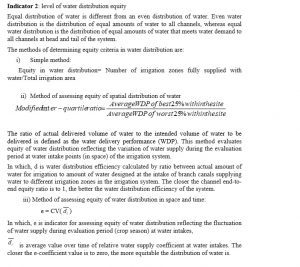
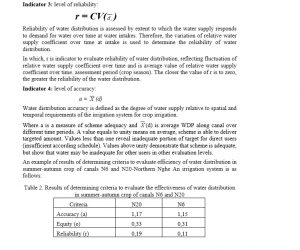
The analysis results show that in general, the water distribution efficiency in both N6 and N20 canals is not high. In terms of actual water supply in whole crop, tertiary canals of both canals are supplied water exceeding water demand of crops. Value of indicator of equity (e = 0.33 in the N20 canal and e = 0.31 in N6 canal) shows that water distribution is not really equity between tertiary canals at head and tail of irrigation system.
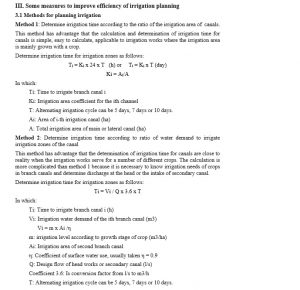
Example of applying method of determining irrigation time according to ratio of irrigation area of canals for planning irrigation for Tay Phuc pumping station (Nghe An province) as below.
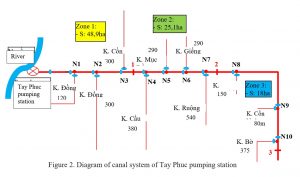

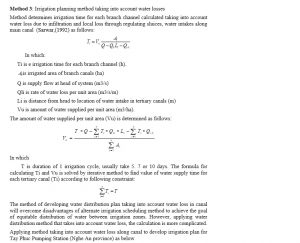
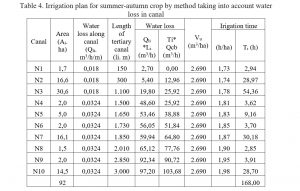
Applying method taking into account water losses to calculate irrigation time as compared to method of determining irrigation plan based on area of each branch canal to test irrigation plan in two crops of Winter-Spring and Summer-Autumn 2015 as below
- Water distribution efficiency:
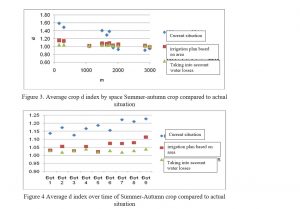
Application of water distribution plan (irrigation schedule) has significantly changed water distribution efficiency of the system. The tributary canals are supplied with enough water and there is no over-taking of branch canals at head of the canal and shortage of water in the tributaries at the tail, so that water shortage of branch canals has been improved. The canals that were previously supplied with too much water are now very limited, approximately enough water compared to demand.
Applying water distribution plan (irrigation schedule) has significantly changed water use efficiency of the system. Actual results of applying alternate distribution plan of irrigation water according to ratio of branch canal area for summer-autumn crop in 2015 also gave a change in relative water supply coefficient (d) for irrigation seasons of whole crop, although still greater than 1 but much reduced compared to current situation in 2014, which means that amount of water supplied for whole crop is still larger, but not much compared to irrigation needs of crops.
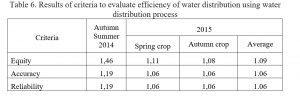
When applying rotational irrigation plan for summer-autumn crop in 2015, water distribution efficiency is quite high because criteria of equity, accuracy and reliability in two experimental crops are approximately 1. This means that water distribution system ensures correct and sufficient irrigation requirements according to water needs and ensures equal distribution of water between head and tail canals, there is no longer situation of taking excess water in head canals
- Water efficiency:
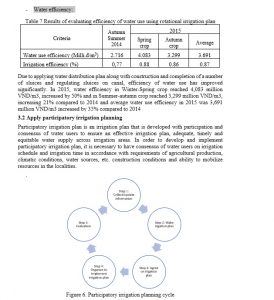
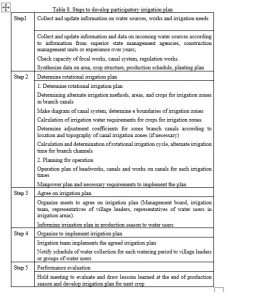
2.3 Apply technical advances to improve efficiency of irrigation plan implementation
In Vietnam, technical advances have been applied in construction and management of on-farm irrigation systems to improve efficiency of on-farm irrigation systems, such as technology in building thin-walled canals to reduce water loss, water metering technology, water control, smart irrigation system. However, the scope of application of technical advances to improve efficiency of on-farm irrigation systems is not much, mainly for pilot projects.
Some applications of advanced technology in water regulation operation improving accuracy in implementing irrigation plans in some pilot projects are as follows:
- Paditch automatic irrigation intake:
Purpose: Automate irrigation and drainage in field in order to control water regime in field and reduce working operation for water distribution.
Structure:
- Automatic Sewer
- Sensor sensor for water entry, water temperature;
- Signal receiver-transmitter
- PC/smartphone/tablet
Feature:
- Monitoring water temperature in field;
- Monitor water level and automatically open and close according to preset irrigation schedule or water level in field;
- Maintain water level in field as required.
Operation: The system can be set up according to predetermined irrigation schedule (by a predetermined date and month, sewer will automatically close and open) or remotely via the web.
Paditch automatic irrigation intakes are installed in Bac Nghe An irrigation system due to JIID support in Yen Thanh, Nghe An as below

- Automatic water level monitoring station:
Installing an automatic water level monitoring station at intake sluices will help to accurately determine water level and intake volume to improve efficiency of irrigation plan.
– Basic features:
- Automatically update water level data to the server every 5 minutes (can be customized accordingly, normally updated once an hour).
- Alert by text message when water level exceeds threshold (Optional);
- Store data locally with a memory card (optional
The equipment is manufactured in Vietnam and has been applied in some places such as Hai Duong, Nam Dinh, Hai Phong… and some locations in Thai Binh province. The equipment ís evaluated by users at installed locations as good efficiency, stable operation, affordable price, easy to apply


